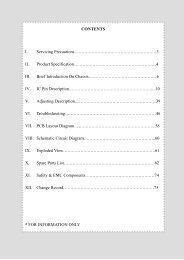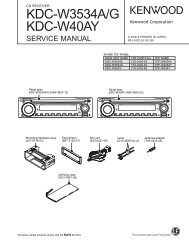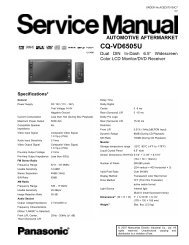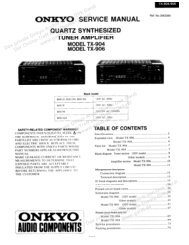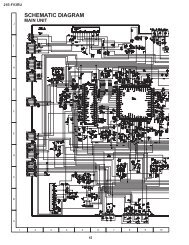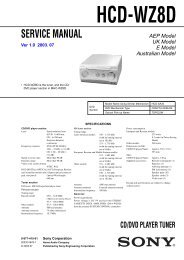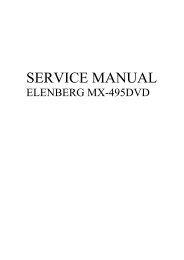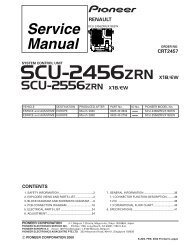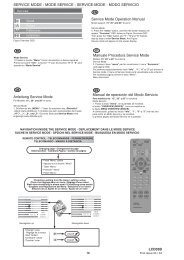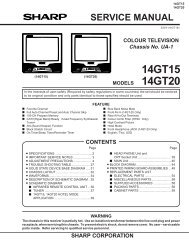Technology of Q 2500 colour TV set
Technology of Q 2500 colour TV set
Technology of Q 2500 colour TV set
Create successful ePaper yourself
Turn your PDF publications into a flip-book with our unique Google optimized e-Paper software.
<strong>Technology</strong> <strong>of</strong> Q <strong>2500</strong> <strong>colour</strong> <strong>TV</strong> <strong>set</strong>The interrupt causes I 2 to load new s<strong>of</strong>twarefrom the memory. Due to the block preselectionfrom the the I2C bus expander, theDSP now loads the s<strong>of</strong>tware for Dolby ProLogic.The DSP processes the I 2 S bus data accordingto the appropriate instructions. The overwhelmingnumber <strong>of</strong> sound parameters to be<strong>set</strong> also occur in the DSP.The DSP feeds the digital sound bus databack to the converter I 2, where the digital/analogueconversion takes place. The 6sound output channels <strong>of</strong> I 2 reach W 301 viathe operational amplifier and the loudspeakermatrix – consisting <strong>of</strong> I 6/9/14.- pin 1 LFE/SUB (deep sound channel)- pin 2 RS (Surround right)- pin 3 LS (Surround left)- pin 4 R (Front right)- pin 5 L (Front left)- pin 6 LC (Center left)- pin 7 RC (Center right)- pin 8 C (Center channel)5.3.3 AC 3 IC functionsCS 4925-01 (I 1)Multi Channel Digital Audio Decoder.- Processes according to the operatingmode, - Circle Surround, Dolby ProLogic Dolby, Digital 5.1 - digital Soundbus-data.- Implements all sound <strong>set</strong>tings, such asheight and depth <strong>set</strong>tings.CS 4226 (I 2)DAC- Converts SPDIF signals into I 2 S bus datafor I 1 .- Converts the I 2 S bus data processed by I1 into analogue signals for the loudspeakermatrix.6 Interface switchingInterface switching is via Q <strong>2500</strong> on the signalboard. Switching <strong>of</strong> the various on and <strong>of</strong>f signalsis implemented essentially by six ICs; twoTEA 6415, two CD 4053 for the video signals,a TEA 6422 and a TEA 6420 for the audiosignal switching. Control is directly from I²Cbus system 3 via SDA 6000. An exception isCD 4053 I 1631 and I 1771.I 1631 switches between the RGB lines <strong>of</strong> theAV3 socket and the RGB signals <strong>of</strong> the DVBdecoder. I 1631 is controlled from a freeswitch output in MSP, which itself is activatedby the CCU via the I2C bus. If the output onpin 78 <strong>of</strong> the MSP is switched to H level, thenL level is felt on pins 9/10/11 <strong>of</strong> I 1631 via inverterQ 1637. With L level on, its control inputI1631 switches to AV3 operation, at H levelthe RGB signals from the DVB decoder areswitched through to the signal processing.I 1771 is used for chroma signal switching if aDigital Link Plus SVHS video recorder is connected.During SVHS operation a chroma signal isexpected from SVHS Digital Link Plus videorecorders on pin 7 <strong>of</strong> the AV socket. For VHSvideo recorders it is pin 15.If the device control detects a SVHS DigitalLink Plus VCR, the chroma signal is switchedto pin 7 <strong>of</strong> the AV1 or AV2 socket on overplayand during a DVB recording. I 1771 isswitched from two switch outputs on pin115/116 I 2311. This in turn is controlled bythe CCU.As the two TEA 6415 must be addressed differentlyfor picture signal switching, pin 7 <strong>of</strong> I1116 is earthed and I 1181 is at the operatingvoltage.The exact signal flow for the video and audiosignals can be obtained from the appropriateflow diagrams.Document Q <strong>2500</strong> 123 © Loewe ProCollege



